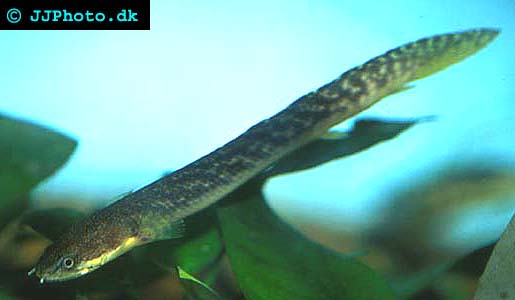Breeding Bichirs
It is impossible to give any general guidelines for the breeding of all Bichir species in aquariums, since they are so different from each other. Some Bichir species have never been successfully bred in aquariums and we do not know what it takes to induce spawning for these fishes. Other Bichirs, such as the Polypterus delhezi, frequently spawn in aquariums. Even with frequently bred Bichirs like the Polypterus delhezi, we are however rather unaware of the exact mechanisms behind the breeding and which factors that triggers breeding.
The Senegal bichir (Polypterus senegalus) is quite often bred in aquariums, and the addition of cooler water is suspected to trigger breeding in this species. It is reasonable to assume that a combination of water changes and temperature changes are key factors here. If you want to breed the Senegal bichir, you should begin buy ensuring that the environment in which you keep the potential parents are perfect for them. The water quality should be superb, frequent water changes must be performed and the aquarium must of course be of suitable size. Keep the pH slightly acidic and make sure the water is soft. A varied diet with plenty of meaty live food is recommended.
The male Bichir distinguish it self from the female Bichir by having a considerably broader anal fin. You can only sex mature Bichirs, since immature males will have an anal fin similar to the anal fin of a female Bichir. Male Bichirs also tend to be smaller than female Bichirs, and some mature Bichir males should allegedly have a thicker dorsal spine than the females.
The Senegal bichir have breeding rituals that typically last for a day or longer. The male Bichir will chase the female, and he will also bump into her with his snout. The female will try to locate a suitable spawning site before she deposits any eggs, and you should therefore provide her with bushy plants before you try to induce breeding. A heavily planted aquarium with bushy and fine-leaved plants is recommended. You can also insert special spawning mops into the aquarium.
The female Bichir will deposit from 100 to 300 eggs during several days. She deposits several eggs each time, and the eggs are fertilized by the male when he cups his anal and caudal fins around the genital area of the female Bichir. The male takes the eggs, fertilizes them and they are then scattered over the plants. A Bichir egg is 2-3 millimetres and slightly adhesive. It will stick to the plants until the fry hatch after three or four days. Bichirs will sometimes eat their own eggs, so it can be a good idea to remove the parents from the aquarium as soon as the final fertilization is finished.
The Bichir fry have external gills. You should wait roughly a week before you start feeding the fry, since they should eat their entire yolk sac first. The first food should be small live food, such as newly hatched Brine Shrimp (Artemia nauplii) or Microworms. Place the food near the fry when you feed them, since newly hatched Bichir fry are not very active hunters. Since older Bichir fry tend to be cannibalistic, you should remove larger fry from smaller fry as they grow if you want to ensure a high overall survival rate.

Polypterus palmas – A somewhat rare bichir. Copyright www.jjphoto.dk
Didn't find the info you were looking for? Register for free and ask your question in our Aquarium forum !
Our knowledgeable staff usually responds to any question within 24 hours
Related Articles
|



